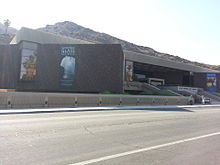Palm Springs Art Museum

Front entrance on Museum Drive in Palm Springs
|
|
| Established | 1938 (as the Desert Museum) |
|---|---|
| Location | 101 Museum Drive, Palm Springs, CA 92262 72-567 Highway 111, Palm Desert, CA 92260 |
| Coordinates | 33°49′27″N 116°33′00″W / 33.82417°N 116.55000°WCoordinates: 33°49′27″N 116°33′00″W / 33.82417°N 116.55000°W |
| Type | Art and performing arts |
| Collection size | ≈ 24,000 objects |
| Director | Elizabeth Armstrong |
| Public transit access |
SunLine Transit Agency Palm Springs: Routes 111, 14, 24, 30, 32 Palm Desert: Routes 111, 32, 50 |
| Website | http://www.psmuseum.org/ |
The Palm Springs Art Museum (formerly the Palm Springs Desert Museum) was founded in 1938, and is a regional art, natural science and performing arts institution for Palm Springs and the Coachella Valley, in Riverside County, California, United States.
The Palm Springs Desert Museum was first housed in 1938 in a small room in La Plaza Arcade on Palm Canyon Drive near 'downtown' Palm Springs. The museum focused on the Colorado Desert natural environment and the original local Native Americans, such as the Cahuilla people. On the edge of the present-day business district, the arcade was a gathering place for residents. Soon the growing museum found temporary new quarters in a section of the town's library. During World War II it was operated by biologist T. D. A. Cockerell. It then expanded in 1947 into a section of a converted wartime hospital. Folk singer and marine biologist Sam Hinton served as director from 1942–1944. The Desert Museum had evolved to reflect the community's growing interest in its natural science and American Indian collections and programs. In 1952 the desert wildlife reserve habitat natural 'open air natural history museum' and botanical garden was added, and the name for all was the Palm Springs Desert Museum.
The Desert Museum started to transition to an art museum in 1953 when desert landscape paintings by Carl Eytel were donated by Cornelia White, Isabel Chase, and Earl Coffman. A new modern 10,000-square-foot (930 m2) structure was built for the Art Museum component in downtown Palm Springs in 1958, and in 1962 it expanded for an auditorium and new galleries to house contemporary art exhibitions. Frederick Sleight – anthropologist and Executive Director – is credited with guiding the transformation.
...
Wikipedia
